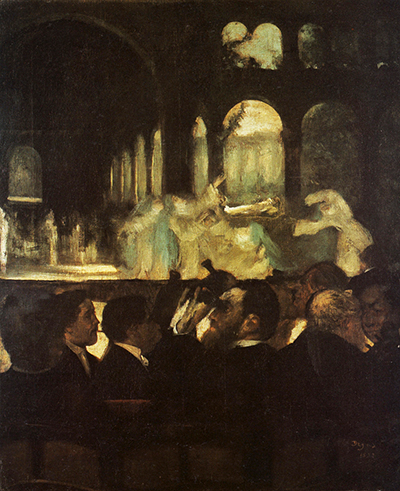The artist's grand obsession with ballerinas was met with his constant ability to attend performances and gave at the art. The Ballet Scene From Robert La Diable showcases the exact viewpoint a viewer in the audience had of the performance. This enables the viewer of the piece to receive a rather easier understanding of what it is that went on at the time.
Degas often preferred to use a perspective as if he was on the stage watching the performance. This is evident in pieces such as Four Dancers, Russian Dancers, and Ballet Scene. Yet, rather Degas was seated in the audience as the other members, and was unable to ever get the perfect view. Yet, the artist had such a desire to see the art up close, that within his work he created the perspective as if he could have touched the ballerinas. This painting does not hold the same story, as instead it showcases the simple truth of what actually occurred. The dark painting doesnÕt use exact detailing, and instead is a dark piece lacking any light. The viewer is able to witness a grand audience of men looking onto the performance. It seems as if the perspective of the piece is based on someone in the mid-section of the audience. These male heads bleed into one another with no specific outline showcasing their bodies. This is a classic technique used in impressionism. The style does not care to outline figures throughout the piece, and instead feel as if the colours and forms make it all come alive.
While the viewer can mostly see the back of these men's heads, a few can be seen at a side profile. The men near the lower centre of the piece lifts his head as he looks to the left. He has a thick beard and bushy eyebrows that give him a serious look. To his left, another man looks to the right, away from the stage. Upon further inspection, the viewer can witness a sheet of music in front of the man, implying that he is one of the musicians part of the orchestra. Nevertheless, whether these man are part of the orchestra or the audience, it seems as if they are all mixed among each other. While Degas usually uses immense detail to showcase the ballerinas on stage, he instead opts to not do so. The artist instead merged all of the bodies on stage as one. Blue and white lines illustrate figures, yet it is difficult to make anything else out.
Upon initially analyzing the piece, the viewer cannot even tell that these are ballerinas performing. The setting continues to be filled with this dark shade, as the background of the piece is coloured in dark shades of black and brown. Additional columns fill the back wall of the setting, adding greater dimension and height. It's difficult to tell whether the lighted areas are illuminated by a light source from outside, or are simply a part of the set painted. The viewer can make out that the room is rather large as the stage expands from the left to the right. While this oil on canvas piece is immensely dark to make out exact details, it still remains as a classic. This is a more authentic approach for the artist apart from the classic impressionist pieces he created that showcases the beauty of ballerinas up close. Rather, often enough performances were performed as shown here, without endless colours and bright lighting.




